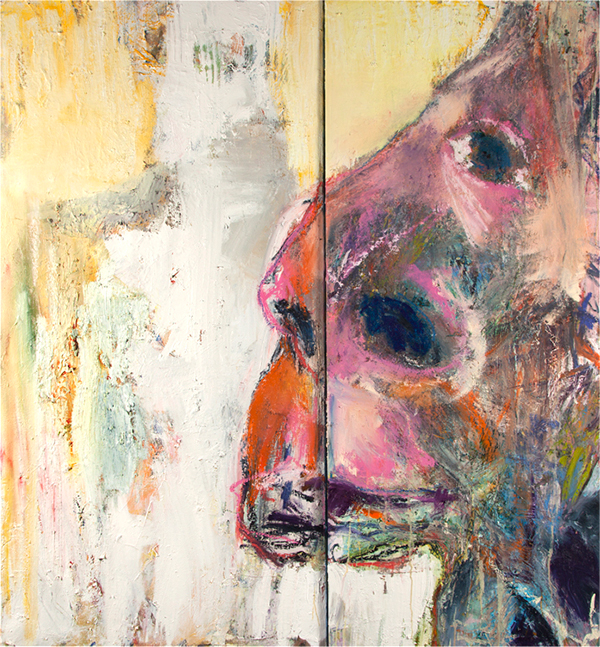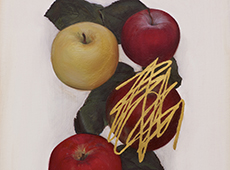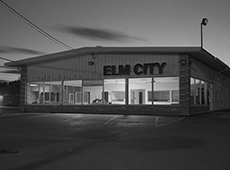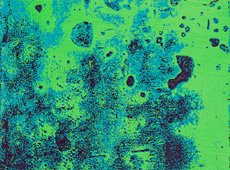What this painting confirms for me is that the painting process is an exchange between internal and externalized aspects of the artist’s subjective, emotional life. Intense looking and reacting to one’s own marks and moves on the canvas over time constitute the substance of that exchange. Ultimately, even when I start with a model, I end up interacting with my own marks, my own…

Karen Schwartz, “Shadow of His Former Self.” Mixed Media on Wood Panel and Linen, 66 x 72 in. 2013.
© Karen Schwartz. Courtesy of the artist and Life on Mars Gallery, Bushwick
This painting came into being late in the process of creating it. It began as a human figure, as so many of mine do. I worked with a nude male model on an angular hand-on-hip-with-pointed-elbow pose for a number of painting sessions. After many instances of painting it in and out, that elbow became a nose and cast the shadowed profile that assumes the knowing presence, framing the one eye that meets the viewer, inviting complicity, saying, “I know” or “See what I mean?”
My husband declared it the most hideous painting he had seen me do when he first laid eyes on it. Then he stared at it and cried. I knew it would upset him. The painting disturbed me too, and so, I knew it was undeniable and had to be welcomed into being.
This painting proves to me that something I write about as a psychoanalytic psychotherapist (I am artist and psychologist) is true. I don’t always know that what I write is true. But I tend to trust what I paint, because I don’t set out with a preconceived agenda when I paint. I don’t think in an explicit sense when I paint. Painting is thinking.
What this painting confirms for me is that the painting process is an exchange between internal and externalized aspects of the artist’s subjective, emotional life. Intense looking and reacting to one’s own marks and moves on the canvas over time constitute the substance of that exchange. Ultimately, even when I start with a model, I end up interacting with my own marks, my own externalized experience of the model. Painting gets me into a deepening engagement with myself that is recorded in the painting and engages viewers too. I am very interested in sharing the process of creating and involving my viewer in that; I hope that the ambiguity of abstracted content, the loose and free mark making, and the transparency and spontaneity of my process serve those aims.
…I tend to trust what I paint, because I don’t set out with a preconceived agenda… . I don’t think in an explicit sense when I paint. Painting is thinking.
When I made this painting, despair and loss associated with a zombie stage of my husband’s recovery from having two knees replaced dictated. I did not go into the studio thinking I would paint these feelings or this subject matter. But I started to see things in the painting and in my struggle to find some coherency in form. I painted over both panels repeatedly, added collage elements and stripped them off, viciously poured and scraped over parts that I did not want to see anymore. The two panels came about because I ran out of room and wanted more for the original figure’s elbow. My studio mate saw the elbow as part of a face. I went with that and then there was something to which that big nose and sad eye were referring –an emerging white ghost of a figure that started to manifest, the way a form starts to be visible in a darkroom processed photograph sitting in developer chemicals. I felt very excited when that whitish figure started to emerge and knew I had something true.
I don’t care that my painting is ugly. That is as good as beautiful. I care that it violates my own expectations, reveals an inner state that I had not been explicitly aware of and could not have articulated without “reading” it in my painting. Psychotherapy is a way of making sense and making implicit knowing and human experience available to conscious awareness, explicit, narrative, and shared. So is painting. Both painting and psychotherapy come alive in those moments when human understanding and connectedness ignite.
Karen Schwartz lives and paints in Atlanta, GA. A Shadow of His Former Self is on view at Life on Mars Gallery, Bushwick, thru 12/22.
Editor’s Recs:
Read snips from our conversation with Painting Impossible curator, painter Michael David here and here.
Follow our discussion on the possibilities of painting here.
Subscribe to Tilted Arc
If you like this story, please consider subscribing. We are sticklers for privacy.
We will never sell or share your e-mail address.



